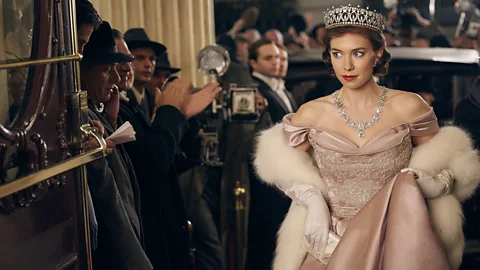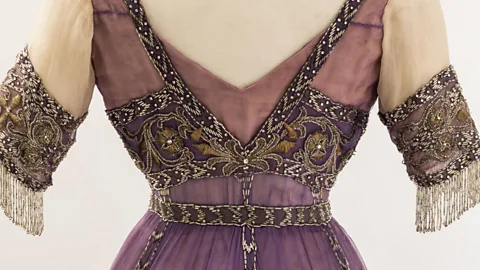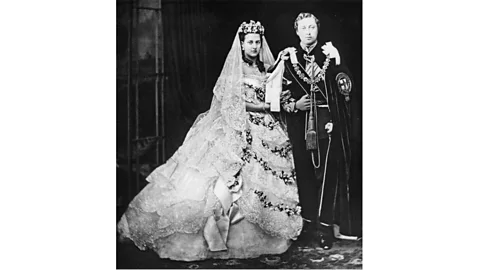How royal women have shaped fashion
 Netflix
NetflixThe 'Meghan effect' is nothing new. From the Danish style icon Queen Alexandra, to the aloof yet bohemian Princess Margaret, the royal influencers who have blazed a trail.
There is it seems no stopping the so-called ‘Meghan effect’ – the phenomenon where every item of clothing Meghan Markle wears immediately sells out. The white coat by Canadian brand Line, worn by Prince Harry’s soon-to-be bride for the couple’s engagement announcement, proved so popular that the company’s website crashed – soon after, the brand officially named the coat ‘the Meghan’. Meanwhile, traffic to the website of jewellery brand Birks increased 400 per cent, and even a simple black jumper from Marks and Spencer sold out twice after Markle wore it for a public engagement. And this is even before any sign of the bride’s choice of wedding dress, already sparking febrile speculation in fashion circles, and, needless to say, sure to lead to new bridal trends.
 Museum of Fashion, Bath
Museum of Fashion, BathThe phenomenon of royal women influencing fashion is nothing new, of course. Look no further than the ‘Kate effect’ still being wrought by the Duchess of Cambridge, not to mention the ‘Diana effect’ in the 1980s and 90s. But what is perhaps less known is quite how influential the personal styles of certain royal women were – long before the invention of the internet, or any mass media for that matter. So what does it take to be a royal style icon? And how different – or not – was it then from now?
“The level of scrutiny today is in a different realm,” Elly Summers tells BBC Culture. Summers is curator of an exhibition at the Museum of Fashion in Bath, Royal Women which looks at how various royal women helped shape popular fashion tastes with their own personal styles.
Back in 1863, Princess Alexandra, born into the Danish royal family, married Queen Victoria’s eldest son Prince Albert Edward, otherwise known as ‘Bertie’. Until then, Bertie had been notorious for his string of affairs and was known as a ‘playboy prince’, yet the marriage proved a great success, and the couple were hugely popular.
 Alamy
AlamyIt seems Alexandra was just the kind of royal woman the public were craving. “Queen Victoria had been in mourning dress for years and was quite removed from British society,” explains Summers, “She wore a black austere uniform, and she didn’t attend parties. Edward and Alexandra on the other hand were a dazzling couple who had an active social life, and were seen as more accessible. It was good for the royal family to reconnect with the public again, having been so remote.”
And, as it turned out, the popular Alexandra also became a huge influencer of fashion. “She was a fashion icon and people would copy what she was wearing,” says Summers. “She forged her own look, she was very involved in crafting her image, and she was a trend setter, even if it wasn’t necessarily on purpose. “
 Museum of Fashion, Bath
Museum of Fashion, BathNot that the Danish princess was allowed complete sartorial freedom and independence. Her future mother-in-law Queen Victoria was insistent that Alexandra wear British lace for her wedding, rather than the Belgian creation that the princess had been offered by the King of Belgium. “The Queen was adamant that she was becoming British and it was important to display that,” says Summers. “It was a new identity and she was told to align her identity with Britishness.”
As a result the wedding dress Princess Alexandra wore was lavishly decorated with British-made Honiton bobbin lace, making a strong statement that she was putting her new country first. There was orange blossom adorning the gown, and it was worn with a voluminous veil. The design of the fabric included delicate roses, shamrocks and thistles, the traditional symbols of England, Ireland and Scotland.
 Alamy
AlamyAlexandra did however insist on one alteration, the reduction in the width of the originally vast crinoline skirt. Also, just a few days after the wedding, the dress was, on her unsentimental insistence, whisked away in order to be completely re-made, pared down and simplified. “Alexandra favoured simple designs,” says Summers. “She had a different, more practical, sensibility. She was from a branch of the Danish royals that was not wealthy, didn’t live in luxury, and her wedding trousseau was small.”
 Fashion Museum, Bath
Fashion Museum, BathAlexandra was the first woman in British public life to favour tailored looks for daytime, which had previously only been associated with riding coats and other sportswear. A cream wool double-breasted yachting jacket by Vernon and a smartly-cut waistcoat by Bussbein are two examples in the exhibition of what was then a daring new look. As Summers points out: “Tailored suiting for women’s daywear is now a successful formula, but previously had been only in the male domain.”
Perfect princess?
In the 20th Century, royal women continued to influence fashion. As the sister of the Queen, the late Princess Margaret had complex and often contradictory expectations put upon her. She had more freedom to express her own taste, and as a result was considered more of a fashion icon than the monarch.
 Alamy
AlamyAs a young woman, Margaret was a favourite with the press because of her glamorous, fashionable image, yet she was also intensely scrutinised, and her love life often made headlines. During the post-war years her socialite reputation and the shenanigans of the bohemian ‘Margaret Set’ were a source of great interest to many. And her recent portrayal in TV series The Crown has brought her sense of style – and occasionally maverick ways – to a new audience.
 Netflix
NetflixPrincess Margaret’s glamorous sensibility was clear early on. She was just 17 when, in 1947, she met Christian Dior, who had come to London to the Savoy to show his iconic, groundbreaking New Look collection. Margaret and her mother Queen Elizabeth the Queen Mother were both keen to see the collection, and so after the fashion show, the dresses were secretly smuggled out of the Savoy and taken to the French Embassy, where the two royal women had a private viewing. Christian Dior described Princess Margaret as “a real fairy princess, delicate, graceful, exquisite”.

Certainly she cut a stunning figure in the delicate Dior cream-silk dress that she wore to Royal Ascot in 1952. With its chiffon, boned bodice, skirt and asymmetrical bolero, it was exquisite and delicate. Paired with elegant, elbow-length black gloves and a wide-brimmed cream-and-black hat, the outfit rendered Margaret a model of princessy perfection.
 Fashion Museum, Bath
Fashion Museum, BathA year later, the black-and-pink lace evening dress by Norman Hartnell that Margaret wore to a performance of Guys and Dolls was another stunning gown. It was just a few weeks after the news of her unsuitable romance with the Group Captain Peter Townsend had broken in the press. The dress was an unapologetically glamorous choice, suggesting a certain grandeur and defiance in the face of criticism.
 Netflix
NetflixMargaret had something of a reputation for haughtiness, but she also had her moments of appropriateness and diplomacy. When she wore a red-and-white cotton evening dress, it was an unusual, unostentatious choice of fabric for eveningwear. It was, in fact, a nod to the British textiles industry in times of post-war austerity. As a member of the royal family, there was always an underlying expectation to promote British industry.
 Alamy
AlamySo how do 21st-Century expectations of royal women differ from the past? “There are still key considerations in every ensemble, and royal women still need to balance all factors,” says Summers. “Now I think it is similar, but more intensified and more immediate. People have always wanted to have the dresses worn by royalty but before, for instance with Princess Alexandra, women in court asked their dress makers to make them something similar, then ladies in aristocratic circles copied them, and then it filtered down to the general public. Now it’s more immediate, it is straight to the high street.
{"image":{"pid":"p0654ymh ","seq":0}}
“In some respects it was easier in the 19th Century and early 20th Century, as it was not a media age,” says Summers. “You just dressed for a particular event – now you have to dress for everyone all the time.
 Netflix
Netflix“But still now, royal women wouldn’t go to a ball informally dressed,” she adds. “People always want to see the royal women dressed in beautiful clothes, they’d be disappointed if they weren’t.”
Royal Women: Public Life, Personal Style is at the Fashion Museum, Bath until 28 April 2019.
If you would like to comment on this story or anything else you have seen on BBC Culture, head over to our Facebook page or message us on Twitter.
And if you liked this story, sign up for the weekly bbc.com features newsletter, called “If You Only Read 6 Things This Week”. A handpicked selection of stories from BBC Future, Earth, Culture, Capital and Travel, delivered to your inbox every Friday.
